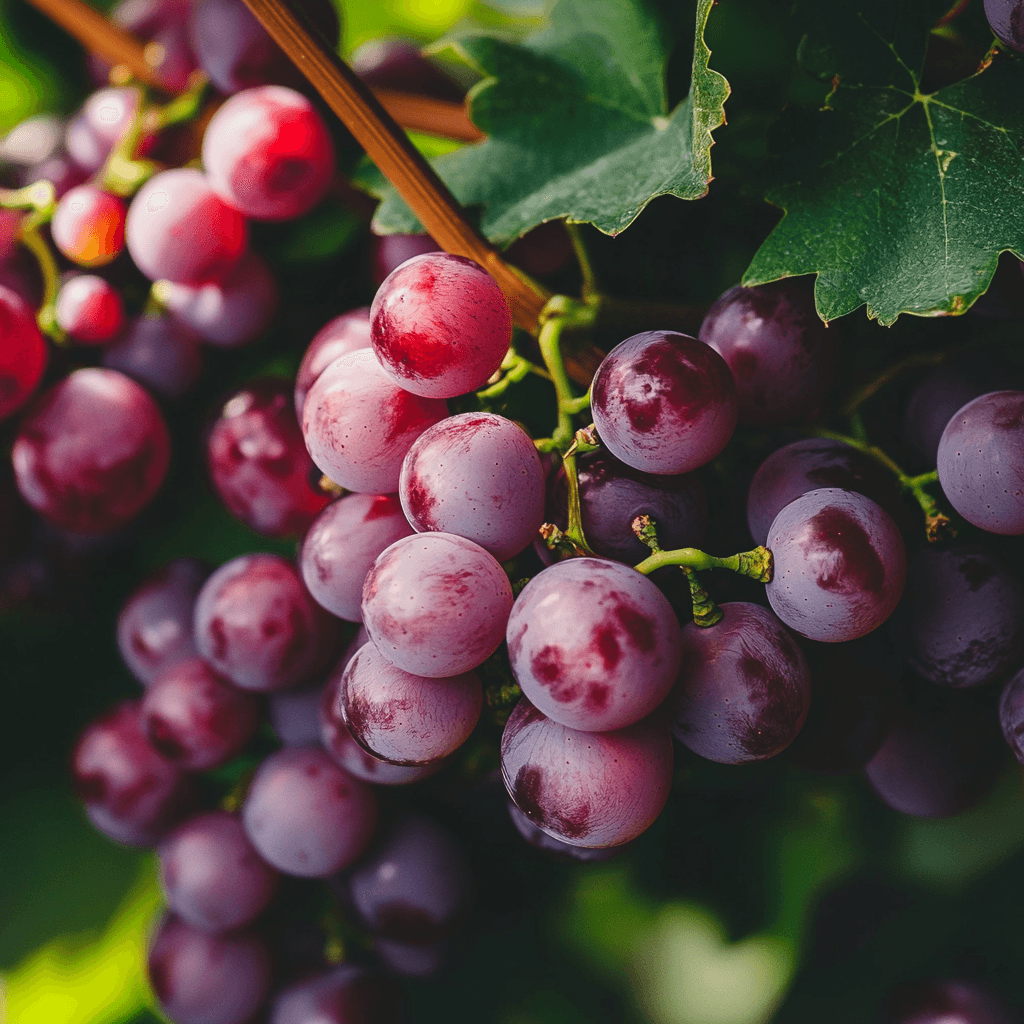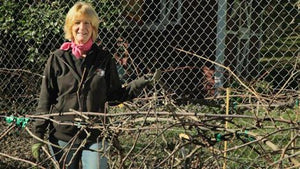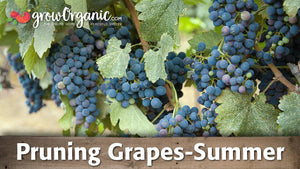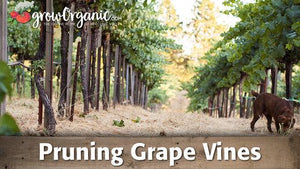Item Number: FV010
Flame Seedless Table Grape Vine
Juicy red grapes with bold sweetness.
Mix-and-match for free shipping when purchasing 6 or more perennial berries, vines, or crowns!
Flame Seedless grapes are a popular variety known for their medium-sized, bright red fruit with a crisp texture and bold sweetness. These grapes are perfect for fresh eating, adding to salads, or snacking. Thriving in full sun and well-draining soil, Flame Seedless vines are vigorous and highly productive, ripening mid-season. With their attractive color, delicious flavor, and versatility, Flame Seedless grapes are a must-have for home gardeners and vineyard enthusiasts.
- Bare Root Vine
- Variety: European
- Zones: 7-11
- Pruning: Cane or Spur Prune
- Harvest: July - August
- Fruit: Light red, attractive, seedless, sweet and crisp berry.
Flame Seedless Table Grape Vines are a popular variety in both home gardens and commercial vineyards due to their versatility, flavor, and productivity. These vines produce light red, seedless grapes that are sweet and crisp, making them ideal for fresh eating, wine production, and drying into raisins. With their ability to grow well in USDA zones 7-11, they are widely cultivated in warm climates, particularly in California, where the grape-growing industry thrives.
Growing Grapes: Understanding the Flame Seedless Variety
Flame Seedless is a European variety derived from the Vitis vinifera species. European grapes are favored for their wine-like flavors, tight skins, and their heat requirements for ripening. These traits make Flame Seedless well-suited for warm regions with long growing seasons. However, they do not perform as well in damp climates due to susceptibility to diseases like powdery mildew.
Flame Seedless thrives in sunny locations with deep, moderately fertile soils. Good drainage is essential, as grapevines do not tolerate waterlogged conditions. In areas with heavy soils, amending the soil with organic matter and creating raised beds may help improve drainage. Flame Seedless vines are self-rooted, meaning they grow from cuttings rather than grafted onto rootstock. These vines are known for being vigorous and productive, but regular care is needed to ensure high-quality fruit production.
Climate Requirements and Planting
Flame Seedless grapes are best suited for warm climates, with USDA hardiness zones 7-11 providing the ideal growing conditions. In regions with hot summers, these vines excel due to their high heat requirement for proper ripening. However, in cooler areas or those with shorter growing seasons, they may struggle to fully mature.
When planting Flame Seedless grapevines, choose a location with full sun exposure, as grapes need at least 6-8 hours of direct sunlight per day for optimal growth and fruit production. The site should also have good air circulation to help prevent diseases like mildew, which can be problematic in more humid conditions.
Soil Preparation
Grapevines prefer deep, well-draining soils that are moderately fertile. Before planting, it is important to prepare the soil by removing any weeds or debris and tilling the soil to loosen it up. Adding compost or organic matter can improve soil fertility and structure. If planting multiple vines, space them about 6-8 feet apart to allow for sufficient airflow and room for growth.
Dig a hole large enough to accommodate the vine’s roots, ensuring that the crown (where the roots meet the stem) is level with the soil surface. After planting, water the vines thoroughly to help them establish, and consider applying a layer of mulch around the base of the plant to conserve moisture and suppress weed growth.
Grape Pruning for Fruit Production
Proper pruning is essential for Flame Seedless vines to maintain their shape, health, and fruit production. Grapes require regular pruning to remove old wood and encourage the growth of new fruiting canes. Flame Seedless can be pruned using either cane or spur pruning techniques, depending on your trellis system and the specific goals for the vine.
Cane pruning involves selecting a few strong canes from the previous year’s growth and cutting them back to leave around 10-15 buds per cane. This method is commonly used for European grape varieties like Flame Seedless. Spur pruning, on the other hand, involves cutting back fruiting canes to leave short, two- to three-bud spurs along the main vine. This technique is often used in more vigorous varieties and can result in smaller clusters of fruit but with better airflow and reduced disease risk.
Regardless of the pruning method chosen, it’s important to prune grapevines during the dormant season, usually in late winter, before new growth begins in the spring. Regular
pruning helps control the size of the vine, prevents overcrowding, and encourages the production of larger, higher-quality grape clusters.
Watering and Fertilizing
Once established, Flame Seedless grapevines are fairly drought-tolerant, but they will benefit from consistent watering, especially during dry periods and the growing season. Water deeply, ensuring that the moisture reaches the vine’s root zone, but be cautious not to overwater, as waterlogged soils can lead to root rot and other issues.
For fertilization, grapevines typically do well with minimal feeding. In the first year after planting, avoid heavy fertilization to encourage the vine to establish deep roots. In subsequent years, applying a balanced fertilizer in early spring can support healthy growth. Organic options, such as compost or aged manure, can also be beneficial for maintaining soil fertility and structure.
Managing Pests and Diseases
Although Flame Seedless is resistant to cracking, it is susceptible to powdery mildew, which can affect fruit quality and overall health. Powdery mildew is a fungal disease that thrives in warm, humid conditions and can be controlled through regular spraying with sulfur or other fungicides approved for grapevines. Proper pruning and maintaining good air circulation around the vines can also help prevent the spread of mildew.
Other common pests that may affect Flame Seedless grapevines include grape leafhoppers, spider mites, and birds. Using organic insecticides, introducing beneficial insects, and installing bird netting can help manage these issues and protect the fruit.
Harvesting Grapes: When and How
Flame Seedless grapes are typically harvested in July and August, depending on the climate and growing conditions. The grapes should be fully ripe before picking, as they do not continue to ripen after being harvested. Ripe grapes will have a consistent light red color, and the flavor should be sweet and crisp.
When harvesting, use sharp pruning shears to cut the clusters from the vine, taking care not to damage the stems or surrounding foliage. Flame Seedless grapes grow in large, open clusters, and they keep well once harvested, making them ideal for fresh eating or drying into raisins.
Flame Seedless Grapes for Wine Production and Table Grapes
While Flame Seedless is primarily grown as a table grape for fresh consumption, it can also be used for making raisins or wine production. The grapes’ sweet, fruity flavor makes them suitable for producing light, refreshing wines, although they are less commonly used in winemaking compared to other European varieties like Cabernet Sauvignon or Chardonnay.
For those interested in using Flame Seedless grapes for wine production, it’s important to note that the vines require regular care and attention to ensure the highest quality fruit. Proper pruning, watering, and pest management will all play a role in achieving the best results.
Ornamental Uses
In addition to fruit production, Flame Seedless grapevines can serve as attractive ornamental plants. Their lush green foliage and climbing habit make them well-suited for arbors, trellises, or leafy walls, providing shade during the summer months. The vines’ ability to grow vigorously and cover structures quickly adds an element of beauty to any garden or landscape.
Conclusion
Flame Seedless Table Grape Vines are a versatile and productive variety that can be enjoyed fresh, dried, or even in winemaking. With their resistance to cracking, sweet flavor, and seedless character, they have become one of America’s most popular table grapes. By providing the right growing conditions, regular pruning, and proper pest management, Flame Seedless grapevines can thrive and offer bountiful harvests year after year. Whether grown for fruit production or as an ornamental feature, these vines are a valuable addition to any garden in USDA zones 7-11.
Browse our collection of Table Grapes.
Visit our Berry, Vine & Crowns Characteristics Chart to compare growing characteristics for all our berries, vines, and crowns.



Check Your Zone Compatibility:
Compatible with your zone.
Growing Zone for

Our Guarantee To You
Since 1976, we've served our customers at every stage of growing. Please contact us at any time. We are happy to support and assist you.
Shipping Information
Shipping Information
Cannot ship to the following states: HI , AK , PR , GU , VI , WA , ID
Cannot ship via USPS.
Cannot ship via SmartPost.
Shipping Weight: 3.3 lb
Dimensions: 36.0"L x 4.0"W x 4.0"H
Features
Features
- Container Compatible
- Heat Tolerant
- Long-Lived
- Open-Pollinated
Characteristics
Characteristics
Planting & Care
Planting & Care
Useful Information
Useful Information
Guarantee
Guarantee
Limited Dormant Tree & Plant Guarantee
* Claim deadline is June 15th
We guarantee that your dormant tree or plant will arrive in good, viable condition. If your tree arrives in substandard condition, notify us within 3 days of delivery. Please email pictures of the box, inside packaging, the tree and its roots to helpdesk@groworganic.com. We will investigate your claim and process a request to exchange or refund the damaged product.
If your dormant tree or plant has not grown new leaves by June 15th, you may be eligible for our Limited Dormant Tree & Plant Guarantee. This guarantee provides for a store credit for the purchase price of the tree, excluding shipping. Please see the Instructions below.
Important Dates:
- April 1st Dormant trees/plants must be planted in the ground
- May 15th Perform scratch test, if no new leaves have grown
- June 15th Deadline to apply for a dormant tree/plant credit
All required documentation must be received by June 15th for your claim to be considered. Claims or documentation received after June 15th will be denied, without exception. Instructions listed below
Terms and Conditions
We cannot guarantee that your tree or plant will remain alive and healthy after it is received, or bear fruit as there are too many variables in your environment that are beyond our control (i.e. soil preparation, weed and pest control, proper irrigation, chill hours, compatible hardiness for your growing zone, proper choice of pollinator, extreme weather, rodent damage, disease, etc.).
We cannot guarantee that we will be able to provide a replacement tree/plant of the same species either that same growing season or in future years. Customers are responsible for all shipping fees associated with replacement trees and plants.
If we determine that the tree you purchased directly from us is not viable, we will issue you a store credit (not a refund) for the purchase price of the affected dormant tree or plant. Shipping is not included in the dormant tree/plant guarantee. Store credits can be used to purchase any product we sell and are valid for use only until July 1st of the following year.
Historically, 98% of our dormant trees and plants grow and thrive when they have been cared for and planted using our growing guides. Dormant trees and plants must be planted in the ground by April 1st in order to be eligible for credit. If the ground in your area is still frozen solid, you may temporarily plant your tree or plant in a pot.
Potted, non-dormant trees or plants are excluded from this guarantee as they are not dormant at the time of shipment. Evergreen trees such as citrus, avocado and olive trees are not available for credit under the Dormant Tree and Plant Guarantee.
Instructions
We guarantee that your dormant fruit tree or plant will leaf out, if you care for it according to our growing guides. In the unlikely event that your dormant tree or plant does not have leaves by May 15th, follow these simple steps to apply for a store credit:
Before you call or email, please perform a “scratch test” to determine if the tree or plant is still alive. This video shows how to check for live tissue under the bark. Scratch tests need to be done a few inches above and below the graft.
Green Cambium Layer / Living Trees
If the cambium layer under the bark is green, give your tree a little more time. It is still alive, but hasn’t come out of dormancy yet. Check to make sure that it is getting the right amount of deep root water, enough sunlight and that the weather is warm enough for that type of tree/plant to come out of dormancy. Every tree has its own personality and will come out of dormancy at different times. Be sure to submit the required documentation listed below by June 15th, if it doesn’t grow leaves.
Brown Cambium Layer / Dead Trees
If the scratch test shows a brown cambium layer or if your dormant tree/plant doesn’t have leaves by June 1st, please email us at helpdesk@groworganic.com. All required documentation listed below must be received by June 15th for your claim to be considered. To be considered for the guarantee claim, all required documentation must be received by June 15th. Incomplete submissions will be denied.
Required Documentation
- Order number
- Name of dormant tree/plant and the quantity affected
- Photos of each tree or plant showing:
- The roots (tree or plant must be pulled out of the ground)
- The scratch test areas
- The entire tree/plant
We reserve the right to not issue credit for items that have already been replaced. We also reserve the right to require photographic evidence that the tree/plant was not killed by root rot, rodent or mechanical damage.
Share



I received my grape vine about two or three weeks ago. There was no damage to it. It just looked like a woody stem. It’s starting to warm up here and there are buds on all my fruit trees, but I haven’t seen any new growth on the grapevine. But it also isn’t dying. So I guess we just have to wait and see.
I really don't know how the grapes are doing they are in dormant mode but they have been planted.now we sit and wait hopefully they will do fine I don't know the age as far as if they will give us grapes this year or not but it's all a waiting game.
I purchased 3 grapes from PV, and while all grew, Flame outproduced them all. It’s a hearty, vigorous vine, and produces masses of crisp juicy bunches of intensely sweet flavor bombs..I’ve taken my cuttings from when flame was pruned last year, and planted them all over the yard..
The plants arrived with an excellent root system, they took 7 to 10 days to sprout and one month after they already measure about one meter. I am very happy, I hope that next year I will have grapes.
Arrived in great shape and leafed out nicely; next up: harvest!
Videos
Articles
-
 Sun, Jan 07, 2024
Sun, Jan 07, 2024Planting & Growing Grapes
-
 Wed, Mar 12, 2025
Wed, Mar 12, 2025When to Plant Grapes: A Complete Guide to Planting Grapes in Clay Soil and Beyond
-
 Thu, Jul 03, 2025
Thu, Jul 03, 2025Trim Grapes in Summer With Confidence: Learn How to Trim Grape Vines in Summer and the Secrets to Pruning Grape Vines During Growing Season
-
 Thu, Feb 06, 2025
Thu, Feb 06, 2025Planting & Pruning Grape Vines











